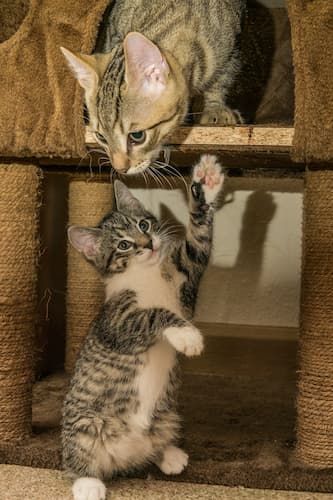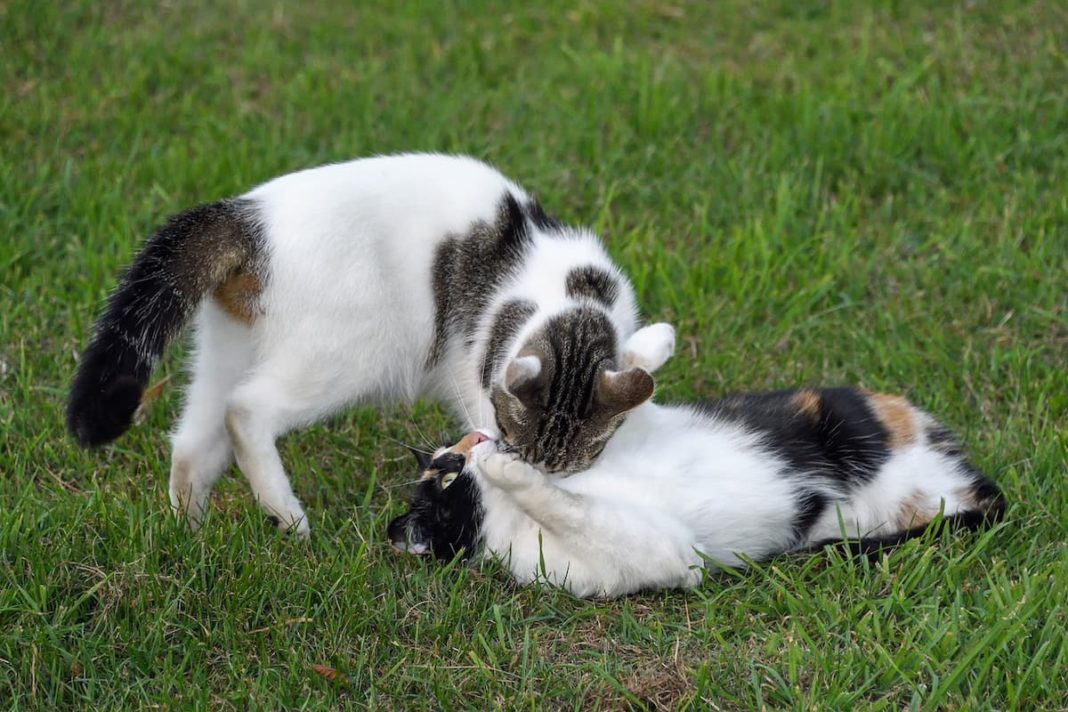Why Does One Cat Want To Play While The Other Doesn’t?
Wondering why one cat wants to play while the other doesn’t? Perhaps you have recently introduced a new cat that you thought would be a brilliant match as a playful companion for your other cat. However, they always seem to be relaxing…separately?
Our cats may not always participate in providing the playful romps and pounces we’d like to see. Why is it that some adult cats want to play while other cats won’t play? Why is it that some cats just don’t seem to enjoy playing as much in general? Let’s take a look at this mystery of having a disinterested cat.
Reasons Why One Of Your Cats Doesn’t Want To Play
Sometimes, a lack of playful interest can mean that a cat isn’t feeling well. Or it could be that its preferred playtime mightn’t be happening when you’re at home. It’s also possible that the cat is stressed or anxious.
If one of your adult cats never seems to want to bat the mouse around or run, jump, other normal feline behaviors, or play with your other cat, it would be best to first set up an appointment with your veterinarian. Exercise is important to the health of a cat. If there’s no interest in play or exercise, it’s possible that the cat may be feeling unwell, stressed, or in discomfort. Being proactive now can help get to the root of the health concern earlier rather than later.
Cats, like their owners, have preferences. Whatever activity or toy you’ve introduced to your cat simply may not interest them. Try out a few additional toys and activities. If your tendency is to leave toys lying around for the cat, perhaps your cat needs interaction with you. You should try more direct stimulation like a laser pointer to see if that engages the cat.
Take the time to figure out what type of play the cat enjoys. And, of course, the most important thing to do is to rule out any underlying health or behavioral concerns that may be the root of it. If the cat still isn’t interested, let’s try some playtime inspiration.

Ways To Inspire Playtime With A Cat
Most cats love to sit on your lap or lie in the sun, but behavioral enrichment and play are a good part of overall good health. Let’s try to get one of your adult cats into action with a little inspiration! Here are ways you can create a more interesting playtime routine for the cat that you’re concerned about:
You can change out the regular food bowl with puzzle-type bowls to challenge the cat during mealtime.
Try spending time interacting with the cat individually each day. Although toys can be good enrichment, there’s no better way to encourage activity than for their owner to be part of the fun.
Cats, as a part of their behavioral drive, need to be able to climb. If you don’t have any practical vertical spaces for the cat, try adding a cat tree or scratching post. Make sure there’s enough height for the cat, so they can get in some climbing. Window perches are also very useful for this!
Whenever you’re gone during the day, turn on YouTube playlists that feature birds or other animals to pique your cat’s interest.
Encouraging Two Cats To Play Together
Cats usually don’t automatically interact with each other, particularly if there’s a big age difference or your first cat has been used to having life all his own way. There’re lots of ways to encourage cats to get along, however, it’s important to take things slowly and not force them together before they’re ready.
During playtime, try interacting with both of your cats at the same time. If one cat refuses to approach while the other cat is there, then split your time equally between the two. Make sure the timider of the pair gets their own space to retreat to. When given time and patience, the two should start coming forward for playtime together – and gradually progress to playing with each other, as time goes on.
Cats need a consistent routine to feel safer around their home. That’s why it’s highly recommended to make playtime a routine. Your cat will expect it more over time.
Be Patient
As your cat won’t be happy about breaking their routine, make sure you’re patient in this process.
- Patience is important. You both should be excited about playtime as a routine.
- You can start off with 1 minute of playtime daily.
- Gradually increase playtime by a few minutes each day or every few days.
- As time goes on, you can break it up into 3-4 sessions per day.
- Remember to take a break when the cat gets tired.
- Reminder: You can use rewards like healthy meat-only treats to encourage more playtime in the future. Don’t use cat “dental” treats.
- Being patient will pay off in the end. Remember that you should both be excited about playtime.
Be Persistent
Some people often say that despite trying, the cat still doesn’t want to play.
- Well… in this case, you need to keep trying.
- In the wild, a cat won’t jump at the first sight of prey
- Cats, over time, study prey behavior
- They’ll pounce at the right moment
- Cats always conserve their energy for hunting
- Every moment counts
- Cats conserve their energy for hunting, and the indoor version of hunting is playing. You need to keep that in mind during playtime.
- Some owners say that they’ll wave a wand around for 10 minutes before their cat shows interest.
- Cats save energy for hunting, so it’s important to be persistent. A cat will only pounce at the right moment.
Get Creative And Have Fun
If the cat still isn’t showing much interest in playing, then get creative!
- Mimicking prey movements is a sure way of getting the cat interested in playing.
- Use interactive cat toys like wands or the Cat Dancer.
Provide Enrichment
Cats need lots of enrichment to feel comfortable at home and in their territory.
- The cat won’t play if it doesn’t feel comfortable in its own territory.
- Cat enrichment needs:
- Hunting (aka playing)
- Scratching
- Resting
- Climbing
- Hiding
- Perching
Playing is the cat’s indoor version of hunting. The enrichment is the indoor version of wild stimulation is enrichment.









